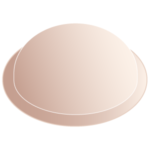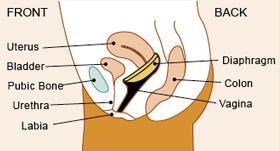Key Facts
- The diaphragm covers the cervix and should always be used with spermicidal cream/gel.
- The diaphragm does not prevent STIs.
- You should get a new diaphragm at least every 2 years.

| Out of 100 people using a diaphragm with spermicidal cream or jelly | |
| Typical use: 12 people become pregnant | |
| Perfect use: 6 people become pregnant | |
What is a (contraceptive) diaphragm and how does it work?
A contraceptive diaphragm is a non-hormonal birth control method that is used to prevent pregnancy. It has a soft latex-free dome with a flexible rim made from silicone. Latex diaphragms are no longer being made; however, they may be available in certain regions outside of the U.S. A diaphragm works by forming a barrier to stop sperm from reaching the cervix to prevent pregnancy. The diaphragm should always be used with spermicidal cream or gel. The spermicide comes with instructions and tells you how much to apply inside the dome before inserting it. The spermicide is used with the diaphragm to kill any sperm that might leak in around the edges of the dome.
Where can I get the diaphragm?
The single-size contraceptive diaphragm called, “Caya®” fits most people, doesn’t require a pelvic exam/fitting, and is available in the United States with a prescription. Other types of diaphragms come in different sizes and must be fitted by a health care provider. The Caya® contraceptive diaphragm varies in price and costs $50-$100. USD. The gel or cream spermicide is bought over-the-counter in a pharmacy or retail store. Each application costs (on average) between $0.60-$3 per dose, and about $8-$15 per package USD.
How do I use the contraceptive diaphragm?
 You can insert the diaphragm just before sexual intercourse or up to two hours before intercourse.
You can insert the diaphragm just before sexual intercourse or up to two hours before intercourse.
- First, empty your bladder (pee) and then wash your hands.
- Before you use the diaphragm for the first time, wash it with mild soap and warm water. Rinse and dry it with a clean dry cloth.
- Check the diaphragm for any tears or holes. (Do not use the diaphragm if you notice that is damaged–use a condom instead). Call your health care provider to get a prescription for a new diaphragm.
- Cover the inside dome and rim with about a tablespoon of the spermicidal gel or cream.
- Insert the diaphragm deep into your vagina.
- Make sure that it is in the right place. It should completely cover your cervix and the rim should be behind your pubic bone.
Removing your diaphragm: Do not remove the diaphragm until 6 hours after intercourse. If you have intercourse again before it is time to take the diaphragm out, you still shouldn’t remove it. Instead, use a condom as additional protection. You shouldn’t keep the diaphragm in for longer than 24 hours (even better if you remove by 12 hours) after intercourse.
- Wash your hands before you remove the diaphragm. It’s also a good idea to check to make sure you don’t have any ragged fingernails that could tear the diaphragm during insertion.
- Remove the diaphragm by sticking your index finger under the rim and gently pulling it out.
- Wash the diaphragm very well with mild soap and warm water, and then dry it completely with a dry clean cloth.
- Put your dry diaphragm back in its original container and keep it there until you use it again. Store it in room temperature (not too hot and not too cold) and keep it away from direct sunlight.
NEVER use a diaphragm during your menstrual period. Use a condom instead.
What if I need more lubrication?
If you need more lubrication, you can use a vaginal lubricant (such as K-Y Jelly). Do not use any oil-based products (such as baby oil, lotion, suntan oil, or vegetable oil) since they can break down the material of the diaphragm and make it less effective.
How effective is the diaphragm against pregnancy?
If a person uses the diaphragm every time they have sexual intercourse and follow instructions every time, it is 94% effective. This means that if 100 people use the diaphragm all the time and always use it correctly, 6 people will become pregnant in a year.
The diaphragm is most effective against pregnancy when it is used correctly and every time you have sexual intercourse. The typical person may not use the diaphragm every time they have sexual intercourse and/or may not always use it correctly. If people use the diaphragm, but not perfectly, it is 88% effective or much less. This means that if 100 people use the diaphragm, at least 12 people will become pregnant in a year.
Does the diaphragm protect against sexually transmitted infections (STIs)?
No. It is important to use condoms in addition to the diaphragm every time you have sex to prevent for STI’s and HIV.
What about douching after intercourse?
Douching is not recommended in general, and it is especially dangerous after intercourse. There are no benefits and it’s not safe because it can cause an increased risk in pelvic inflammatory disease, bacterial vaginosis (an infection of the vagina), and ectopic pregnancy (implantation of the fertilized egg outside of the uterus). Your body makes natural fluids that keep your vagina clean. All you should be using to clean the outside of your vagina is water and soap. However, if you decide to douche in spite of this warning, you should wait at least 6 hours after intercourse so that the spermicide doesn’t get washed away.
Do I ever need to get a new diaphragm?
Yes. The diaphragm should be replaced at least every 2 years or sooner if you notice any damage such as a tear, weak spots in the silicone or if it has discolored. Also, if you have gained or lost more than 10 pounds, had a baby, or if the diaphragm does not fit well, you should talk to your health care provider.
Are there any problems with the use of the diaphragm?
Using a diaphragm can get messy. Also, some people may be allergic to the material of the diaphragm or to the spermicide that is used with the diaphragm. Also, people may be more likely to get a urinary tract infection. Frequent use of spermicide may cause irritation of the vagina wall and increase the risk of acquiring HIV.
What if I have problems with the diaphragm?
Young and adult women who are allergic to latex can safely use the silicone diaphragm. If you have any of the problems listed below, call your health care provider.
- Pain or discomfort while the diaphragm is in place
- Your partner has pain during intercourse
- Soreness in your vagina
- Rash around your vagina
- Frequent bladder infections
- Discharge that smells bad or that comes out in larger amounts than normal
Can any woman use the diaphragm?
No. If you have a change in the shape or elasticity of your vagina from surgery or congenital problems such as spina bifida, you should not use a diaphragm. If you have frequent urinary tract infections using a diaphragm, your health care provider will likely suggest another birth control method.
Should I use any other type of contraception with the diaphragm?
You should always use the spermicide that is meant to be used with the diaphragm. It’s also a good idea to use a male condom when you are using the diaphragm. This will increase the efficacy and protect you against STIs.
Some people prefer using the contraceptive diaphragm over other birth control methods such as those that contain hormone medicine. If you decide to use a diaphragm to prevent pregnancy, it’s important to remember to use it every time you have sex. Women using a barrier method, such as a diaphragm or sponge, should be aware of the very low risk of getting toxic shock syndrome (TSS). Also, women who are allergic to nonoxyl-9 should not use any vaginal barrier method that contains this spermicide or works with spermicide.
Our health guides are developed through a systematic, rigorous process to ensure accuracy, reliability, and trustworthiness. Written and reviewed by experienced healthcare clinicians from Boston Children's Hospital, a Harvard Medical School teaching hospital and consistently ranked as a top hospital by Newsweek and U.S. News & World Report, these guides combine clinical expertise, specialized knowledge, and evidence-based medicine. We also incorporate research and best practices from authoritative sources such as the CDC, NIH, PubMed, top medical journals, and UpToDate.com. Clinical specialists and subject matter experts review and edit each guide, reinforcing our commitment to high-quality, factual, scientifically accurate health information for young people.


